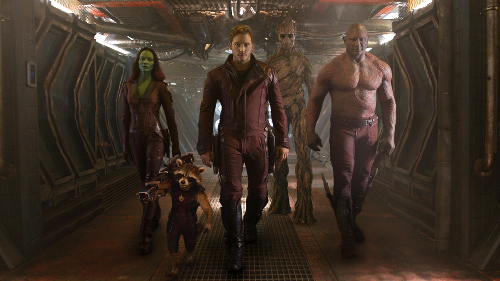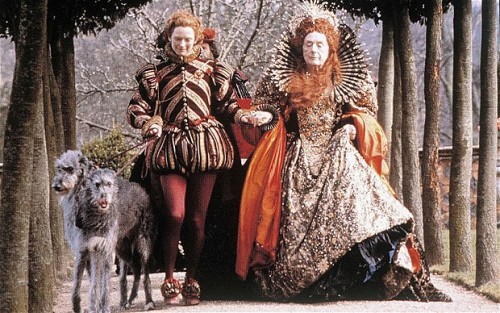This guest post written by Mary Iannone appears as part of our theme week on Superheroines.
“The Marvel Cinematic Universe is kind of a sausage fest,” Stephen Colbert said last week. This was in response to the admission by director Shane Black that Iron Man 3’s villain was originally written as a woman, a choice that was definitively blocked by the studio. If this refusal wasn’t foolish enough to begin with, the reasoning behind it gets even more bizarre – they were afraid the toy version of a woman villain would not sell. “It makes sense,” Colbert sneered. “Girls don’t play with dolls.”
We all recognize the gross disparity of women superheroes, in the Marvel canon and beyond. But I would argue that the cinematic landscape is even less primed to allow women supervillains. After all, if some of us can barely accept the thought of a woman running our country, how can we tolerate even a representation of a woman hungry for world domination?
Villains like Loki, Ultron, Red Skull, and Killian are power-driven, tyrannical, reckless, murderous, and mostly devoid of sentiment. And it’s that last characteristic that seems to be so hard to reconcile with women characters. Time and time again, we see women introduced as villains only to be recruited to the side of the heroes. This usually comes after an “aha” moment when she realizes she is “in too deep.”
Take Scarlet Witch in Avengers: Age of Ultron. She has, as I argued in my last article, quite possibly the most powerful out of any character in the film. But suddenly, after witnessing Ultron’s full plan, her desire for revenge is neutralized. She is horrified by Ultron’s monstrousness: “You said we were going to destroy the Avengers – make a better world!” Just like that, Scarlet Witch becomes an Avenger. She only wanted to destroy a couple of people, not the world.
In Captain America: Civil War, Black Widow starts off on the side of Tony Stark (which is somewhat presented as the villainous side), but swaps midway to assist Steve Rogers. Lest we forget, this isn’t the first time Natasha has swapped sides – off-screen, she started off as a KGB officer who was turned into a S.H.I.E.L.D. agent. This pattern can also be seen with Elektra in Daredevil, Mystique in X-Men, Gamora in Guardians of the Galaxy, and even another character in Iron Man 3, Maya. Go outside of the Marvel Universe, and you will see Catwoman following the same pattern in The Dark Knight Rises; she even ends up in idyllic Paris, having gotten the guy.
Of course, we must note that backlash over woman villains is not confined to the comic book world. Consider the frenzy when Star Wars: The Force Awakens cast Gwendoline Christie as Captain Phasma, commander of the stormtroopers (whose toy is currently out of stock at Toys R’ Us, by the way). The film industry too often listens to the loud corner of the internet that refuses to believe that a woman could be bad (though that same corner doesn’t seem too fond of women as heroes, either).

Women are generally presented as easily manipulated and too emotional to be true villains. It is yet another characterization of the “soft” woman, dictated by her emotions, propelled by a propensity to nurture rather than destroy. But we need stories of women who hunger for power, who are willingly selfish, and who stick to their principles, no matter the cost. People need to know that sometimes, women are just that (minus the desire to destroy the world — most of the time, at least). If audiences can be charmed by Loki, why can’t we react the same way to a woman villain? Why can’t they be just as nuanced?
The stereotype is, again, that women are ruled by their emotions. But why do those emotions have to be good? We’ve called for women superheroes who are not ruled by their ties to men. The same goes for our women villains. No more characters who are only motivated by personal revenge. No more balking when it “gets out of hand.” No more scenes of men talking women into saving the world. Let them try their best to destroy it.
Let’s imagine, for a minute, that the Aldrich Killian character in Iron Man 3 had in fact been a woman. In the finished film, Killian is left on a rooftop on New Year’s Eve, rejected and forgotten by Tony Stark. He then spends over a decade crafting a revenge plan that ends with him attacking the President of the United States (and Tony and Pepper along the way). Had Killian been a woman, this would have been yet another story about a woman scorned and driven mad by rejection. Killian, in his reappearance years after New Year’s Eve, has even gotten a makeover. The characterization is already flawed; crafted into a woman, this would have been a hackneyed, sexist plot that would have done nothing to support the need for deeper women in the comic book universe.
It is ironic, then, that one of the worst-reviewed superhero films of the 21st century actually contains the best depiction of a woman supervillain. X-Men: The Last Stand is, of course, a dreadful conclusion to the series’ original trilogy. But surprisingly, it serves well its most powerful villain, Phoenix.
Jean Grey dies at the end of X2 (aka X-Men 2), only to be saved by her alter ego, Phoenix, whose powers explode outward with lethal force. When Professor Xavier reveals he had been mind-controlling Jean for years to keep Phoenix at bay, Phoenix kills him. “I don’t want to fix it!” she snarls at Logan. While Jean Grey begs to be killed, Phoenix is unrepentant; enraged at those who tamed her for so long, she is determined to destroy those who mean to destroy mutants. In the end, the only way to stop her is by killing her. There is no way to appeal to her emotions; she cannot be coerced into being a hero.
So what’s next? It’s been 10 years since Phoenix – the latest X-Men series has thus far allowed Mystique to only toy with villainy. Cate Blanchett has been cast as Hela in Thor: Ragnarok. Karen Gillan will return as Nebula in Guardians of the Galaxy Vol. 2 (and director James Gunn alluded to an expanded role). But given the positioning of these films in Marvel’s vast Cinematic Universe (MCU), it is likely these women will not factor into the ultimate climax, Infinity War. The presence of Thanos has loomed large in the MCU for years, and he is widely considered to be the mega-villain at the end of Marvel’s Phase Three. Is there anyone who can compete? When will we see her on screen?
Mary Iannone holds a Master’s Degree in Media, Culture, and Communication from NYU, where she studied genre film, Hollywood archetypes, and pop culture’s representations of mental illness. Follow her on Twitter at @mianno.













































